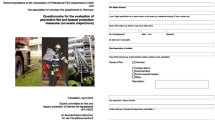Abstract
In recent years research into human behavior in fires has been carried out in several countries for improving provisions for life safety currently prescribed in firesafety codes. This technical note reviews briefly the findings of human behavior studies in the United Kingdom with particular reference to buildings with a large number of people at risk. According to one of the main conclusions of this paper, for successful evacuation, early detection should be followed by timely and convincing communication to building occupants information about the existence, location, and spread of fire. This can be achieved by computer-based informative fire warning systems, which is the subject matter of another technical note.
Similar content being viewed by others
References
Ramachandran, G., “Fire: An Attitude Problem,”Premises Management, Industrial Media Ltd., Tonbridge, Kent, U.K., pp. 24–26 (February 1989).
Ramachandran, G., “The Human Aspects of Fires in Buildings—A Review of Research in the United Kingdom,” inFire Safety: Science and Engineering, ASTM STP 882, T.Z. Harmathy, ed., Philadelphia, pp. 386–422 (1985).
Fire Research 1969, Her Majesty's Stationery Office, London (1970).
Wood, P.G., “A Survey of Behaviour in Fires,” inFires and Human Behaviour D. Canter, ed., John Wiley & Sons, New York, pp. 83–95 (1980).
Wood, P.G., “Behaviour Under Stress: People in Fires,” Ph.D. thesis, Loughborough University of Technology, England (1979).
Canter, D., & Matthews, R., “The Behaviour of People in Fire Situations: Possibilities for Research,” Current Paper CP 11/76, Building Research Establishment, Fire Research Station, Borehamwood, Hertfordshire, England (1976).
Canter, D., Breaux, J., & Sime, J., “Domestic, Multiple Occupancy and Hospital Fires,” inFires and Human Behaviour D. Canter, ed., John Wiley & Sons, New York, pp. 117–136 (1980).
Canter, D., Breaux, J., & Sime, J., private communication (Internal Note). Building Research Establishment, Fire Research Station, Borehamwood, Hertfordshire, England (1983).
Bryan, J.L., “An Examination and Analysis of the Dynamics of the Human Behavior in the MGM Grand Hotel Fire,” National Fire Protection Association (1981).
Bryan, J. L., “An Examination and Analysis of the Dynamics of the Human Behavior in the Westchase Hilton Hotel Fire,” National Fire Protection Association (1983).
Canter, D., “Human Behaviour in Fires in Public Buildings,” Report to Scientific Research and Development Branch, Home Office, London, 1982 (seeFire, April, 1983 p. 575 andFire, May, 1983, p. 659).
Canter, D., “Studies of Human Behaviour in Fire: Empirical Results and their Implications for Education and Design,” Report, Building Research Establishment, Fire Research Station, Borehamwood, Hertfordshire, England (1985).
Author information
Authors and Affiliations
Rights and permissions
About this article
Cite this article
Ramachandran, G. Human behavior in fires—a review of research in the United Kingdom. Fire Technol 26, 149–155 (1990). https://doi.org/10.1007/BF01040179
Issue Date:
DOI: https://doi.org/10.1007/BF01040179




